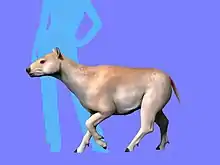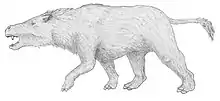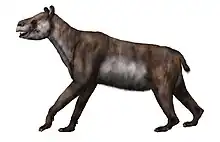| Rosendo pascuali | |
|---|---|
| Scientific classification | |
| Domain: | Eukaryota |
| Kingdom: | Animalia |
| Phylum: | Chordata |
| Class: | Mammalia |
| Order: | †Notoungulata |
| Family: | †Notohippidae |
| Genus: | †Rosendo Wyss et al., 2018 |
| Species: | †R. pascuali |
| Binomial name | |
| †Rosendo pascuali Simpson, (1967) | |
| Synonyms | |
|
Eomorphippus pascuali Simpson, 1967 | |
Rosendo is an extinct genus of notohippid notoungulates that lived during the Early Oligocene in what is now Argentina and Chile. Fossils of this genus have been found in the Sarmiento Formation and the Abanico Formations of Argentina and Chile.
Description
Rosendo was approximately the size of a goat, albeit with a more robust build. It had a heavy and sturdy skull, with a relatively short muzzle. The dentition was characterized by high-crowned (hypsodont) incisors, posterior premolars and molars. The teeth lacked have cementum. The upper incisors were slightly protruding forward. The third upper incisor was wider than the other two, while the fourth premolar was more molariform than the other premolars, but devoid of a distinct hypocone. The upper molars had hypocones, with a variable but generally deep fissure separating them from the protocones. The fissure was blocked by the medial projection of a hooked structure. Apart from the permanent major fossa, the other fossae are erased with wear.[1]
Taxonomy
The genus Rosendo was first described in 2018 by André R. Wyss, based on fossil remains found in Patagonia, in deposits dated to the Early Oligocene. The type species is Rosendo pascuali, whose fossils have also been found in the Sarmiento Formation of Chubut Province, Argentina, as well as the Abanico Formation of Chile.[2] Historically, the genus was originally attributed to the genus Eomorphippus in 1967, described by George Gaylord Simpson,[3] but was subsequently found to be a distinct genus in 2018.[1]
Rosendo is a toxodont, a clade of notoungulates, that developed a remarkable diversity of forms during the Cenozoic. Eomorphippus has been historically included within the family Notohippidae, which included several genera whose hypsodont teeth were similar to those of horses. This family, however, is no longer considered monophyletic.[4]
The following position of the Toxodontia is based on Martínez et al. 2021, showing the position of Rosendo.[4]
| Toxodontia |
|
"Isotemnidae" Paranotohippids "Isotemnidae" "Notohippidae" | |||||||||||||||||||||||||||||||||||||||||||||||||||||||||||||||||||||||||||||||||||||||||||||||||||||||||||||||||||||||||||||||||||||||||||||||||||||||||||||||||||||||||||||||||||||||||||||||||||||||||||||||
References
- 1 2 Wyss, André R.; Flynn, John J.; Croft, Darin A. (2018-06-25). "New Paleogene Notohippids and Leontiniids (Toxodontia; Notoungulata; Mammalia) from the Early Oligocene Tinguiririca Fauna of the Andean Main Range, Central Chile". American Museum Novitates (3903): 1–42. doi:10.1206/3903.1. ISSN 0003-0082.
- ↑ Wyss, André R.; Flynn, John J.; Norell, Mark A.; Swisher, Carl C.; Charrier, Reynaldo; Novacek, Michael J.; McKenna, Malcolm C. (1993). "South America's earliest rodent and recognition of a new interval of mammalian evolution". Nature. 365 (6445): 434–437. Bibcode:1993Natur.365..434W. doi:10.1038/365434a0. ISSN 1476-4687. S2CID 37014680.
- ↑ Simpson, George Gaylord (1967). "The beginning of the age of mammals in South America. Part 2, Systematics : Notoungulata, concluded (Typotheria, Hegetotheria, Toxodonta, Notoungulata incertae sedis), Astrapotheria, Trigonostylopoidea, Pyrotheria, Xenungulata, Mammalia incertae sedis". American Museum Novitates (137). hdl:2246/1621.
- 1 2 Martínez, Gastón; Dozo, María T.; Gelfo, Javier N.; Ciancio, Martín R.; González-José, Rolando (2021-02-11). "A new toxodont (Mammalia, Panperissodactyla, Notoungulata) from the Oligocene of Patagonia, Argentina, and systematic considerations on the paraphyletic 'Notohippidae'". Journal of Systematic Palaeontology. 18 (24): 1995–2013. doi:10.1080/14772019.2021.1872723. ISSN 1477-2019. S2CID 232116246.
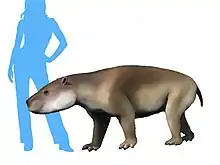
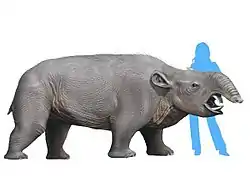

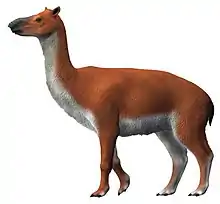
.jpg.webp)
